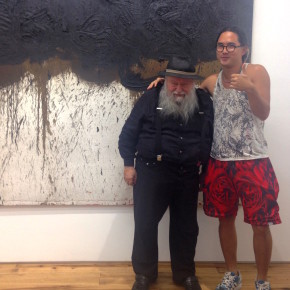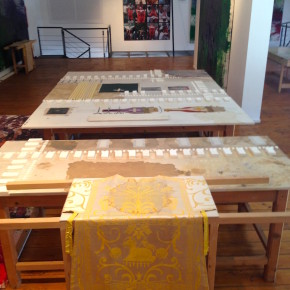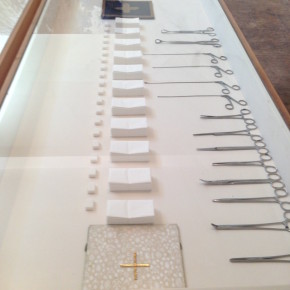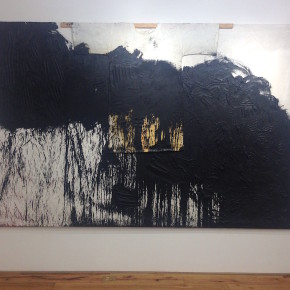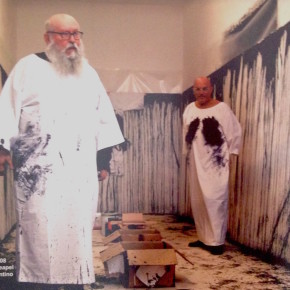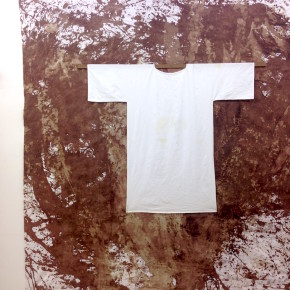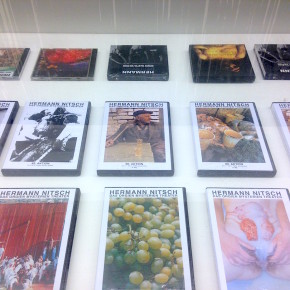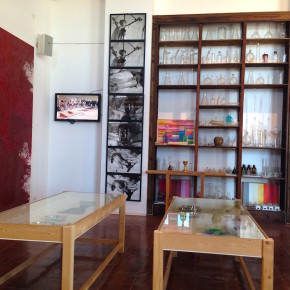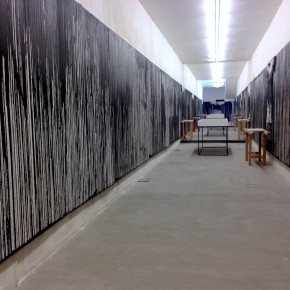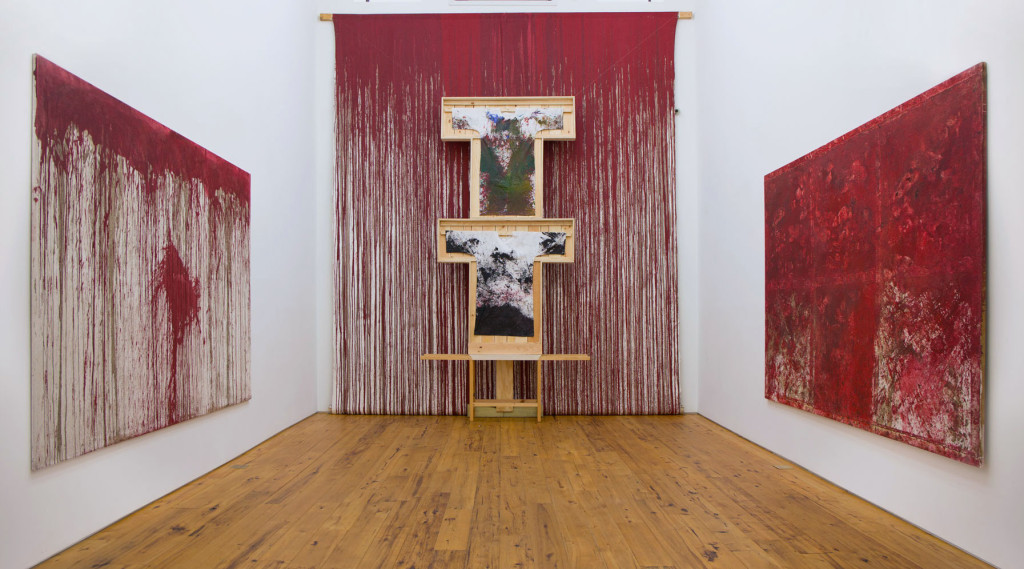
Hermann Nitsch, Installation view at Marc Straus Gallery, NY, Photograph courtesy of the gallery, 2015
Is it possible to think of bodily fluids as something less than repulsive? If the interior of an animal −loins and organs− are brought outside, is it possible to not feel disgust when confronted with the effigy? Through this exposure and depiction, we are reminded of ourselves, our bodies, our delicateness, our mortality. It is here where Hermann Nitsch (b.1938) has found and continues to find his inspiration in art making. He has looked at the body, particularly −blood, mucus, sperm, urine: liquids we leak− and found that these fluids, evident signs of life, could be used and reproduced with other materials such as paint. A chemist at his core, he mixes the artificial with the natural, often using actual blood directly on canvas, initially rich red, then fading to a dull brown when dry, to decipher the truth in representation. In most cases the study is ongoing and without end as people continue to be born, live and die. Is the disgust we feel at the sight of splattered blood something that we are born with or are taught based on the reactions of others? Obviously doctors are able to see and react at the site of blood, whereas the average person on the street may recoil. Nitsch realized that doing this intense and extensive research through theatrical performances resulted in strong reactions from those present watching or looking at documentation after the fact. The Museo Nitsch (Nitsch Museum) in Naples is a living archive of these explorations. The artist, 77, lives in a small town outside of Vienna and has a deep friendship with museum founder and collector Giuseppe Morra. The two met in the 1970s and managed to form a bond even if Morra doesn’t speak German and Nitsch doesn’t speak Italian, their connection is, like the blood splattered artwork, beyond words.
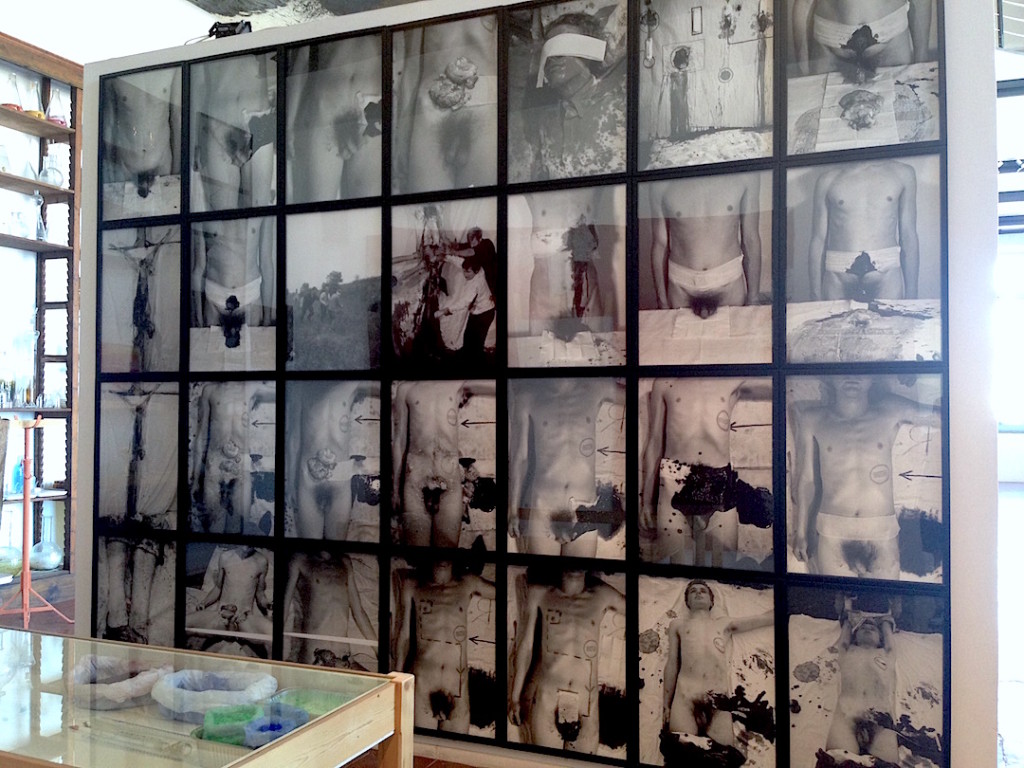
Hermann Nitsch, Installation view (photographic images from performance), at Museo Nitsch, Naples, Photograph Katy Hamer, 2015
Action painting was a performative movement that emerged in the 1940s as artists became less interested in representation and wanted to explore more of a metaphysical approach to surface. Using their own bodies, whether to carry or splash paint onto a surface or to make body specific notation, these artists preferred a more physical tactic in application rather than tool assistance, instead wanting to both connect and erase the signs left once the paint dried. The Viennese Actionists, developed out of this movement in the 1960s, establishing a deeper connection between body and resulting artwork, often cutting or physically harming oneself for the sake of release or sculptural necessity. Hermann Nitsch is interested in the pure and even spiritual exploration of life through the practice of art. Elements of his performance could be described as live painting, even if ritualistic and at times unsettling. He performed with a troupe in tow, nearly 100 artworks in the public sphere between 1960 and 1998. Culturally, the Western world, specifically in North America, is not used to blood and flayed skin without having the consequence (or reference) of pain, violence, or death. Our meats come packaged blood free in styrofoam containers wrapped in clear plastic. The hacking of skin and bone are done in private, behind closed doors of factories and such, not meant for public viewing or consumption. Today, sacrificial practices, still relevant in certain parts of the world, are mostly taboo.
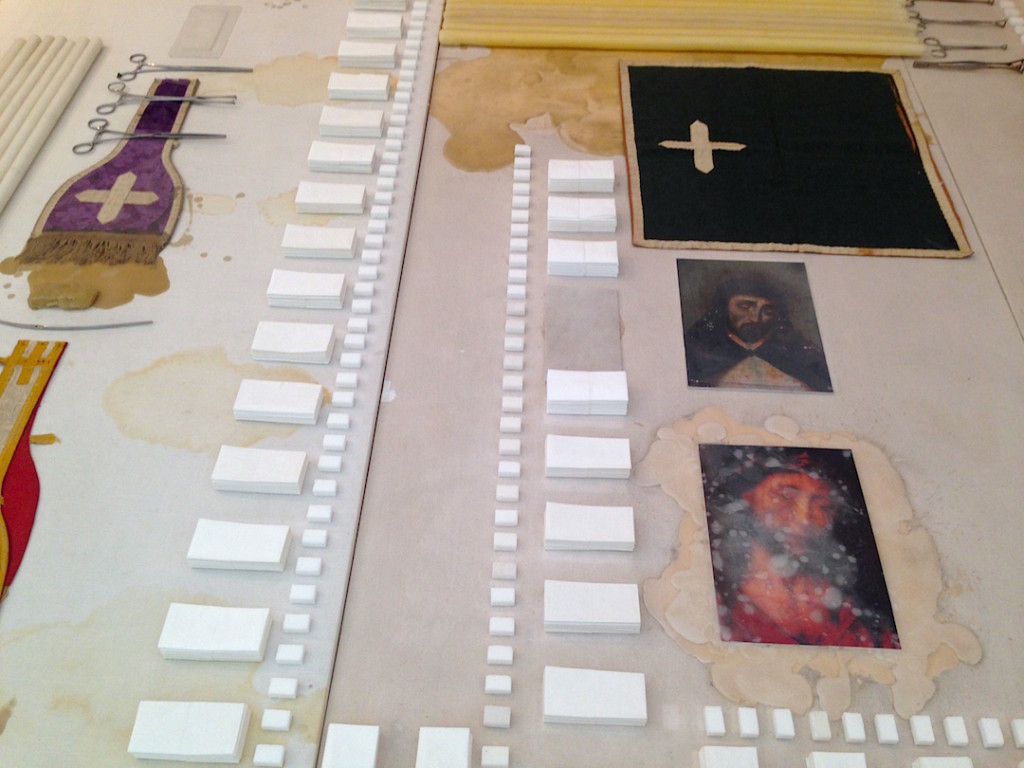
Hermann Nitsch, Installation view, Tissues, wax and ephemera in glass case at Museo Nitsch, Naples, Photograph Katy Hamer, 2015
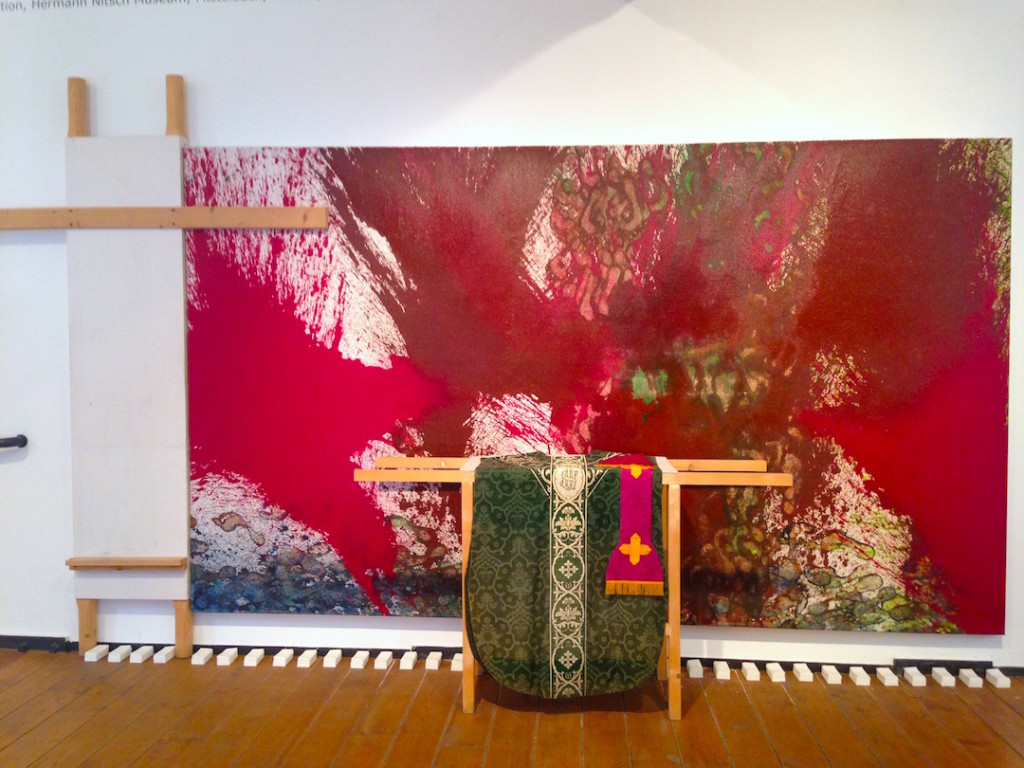
Hermann Nitsch, Installation view (painting, 2009, on loan from the Hermann Nitsch Museum, Mistelbach, Austria), at Museo Nitsch, Naples, Photograph Katy Hamer, 2015
The most direct −if obvious− American artist who was cross-disciplinary within this movement was Jackson Pollack, who threw and splattered paint occasionally using a brush to push around the soft material. Abstract Expressionists worked with non-objective shapes to make complex surfaces. Nitsch uses, liquids that if not always paint, emulate paint in the same way on their chosen grounds. His works however are less about purity of composition allowing for a happenstance that can be made by a footprint of a participant or finger smear. In 2011 Nitsch recruited volunteers to participate in a live action painting performance at the Mike Weiss Gallery in New York. The resulting artwork was installed at the Nitsch Museum at the time of my visit. Beyond that, his work has had limited exposure in the US and one can only imagine it may be partially due to the residual content and seemingly unpleasent initial reaction that many have, specifically around the performative work. At another New York exhibition at Marc Straus gallery in the Lower East Side (September 9th – October 18th, 2015), paintings shown range from as early as 1992 up until 2013. From this selection, a few have been made with cow’s blood, the now dried, dark stain appearing a chestnut-brown and layered with acrylic paint, both mediums (one natural the other synthetic) coexisting on the surface. The gallery arranged a panel discussion with art writers Paul Laster and Robert C. Morgan and Jonathan Goodman, who discussed Nitsch’s work at length while the artist, now a bit bent and aged, still a vivid glimmer in his eye, was present in the audience. Artist Korakrit Arunanondchai made an appearance, colliding worlds between past and contemporary art present, merging Europe, Asia and the US. On Nitsch, Paul Laster said,
“Nitsch’s work offers a link between religion −and I’m not a religious person although I grew up with a religious situation− and art. I found that when I was working at the Museum of Modern Art, art became my religion. I see Hermann’s work, [in dialogue with] cave drawings through reference of hands and feet, pig rituals and the religious groups who performed those types of ceremonial behaviors. For us as art lovers, our churches are the Museum of Modern Art, the Guggenheim and the Whitney. We go there and have a spiritual moment.” Then continuing, “These works [in these spaces] become something spiritual because they’ve been spiritually made and it goes back to the roots of where religions were born [continuing to] to the present day and how we think of spiritual involvement through art.”
In pausing, one can think of the gesture of taking communion, what it is to drink a substance that represents blood, the body of Christ, a sacrificial offering in the form of a libation. This hierarchical representation of liquid, can also be found or transposed through paint. Following Laster, Jonathan Goodman responded on the ‘disorientation’ he felt upon first seeing Nitsch’s work,
“As a teacher, I keep telling my students that I’m a survivor of all the academic theories. We’re not here [in art school] because of ideas, we’re here probably because something hit us in the gut, when we were growing up and art really made a difference to us. I think that our training has distanced us from an emotional approach to art. I don’t want to go on about emotionalism for its own sake, I will say that Nitsch’s directness of emotion and directness of phonic perception of meaningfulness, especially in regards to the materials −both Paul and Robert mentioned about blood in the paint, and the ritual use of slaughtered animals− all these things add up to a physical reality that we’re not very used to in American contemporary art culture and I was uncomfortable with it not because Nitsch was wrong, but because I didn’t have the experience with seeing this work and allowing it to maneuver through me. Once I started to see it, I was able to appreciate it for what it is. We have to allow for the fact that this is a ritual, almost religious fastening of primal emotions that are not going to go away because of our unconscious, and these basic emotions are so powerful, that we have to acknowledge them, and to his credit, Nitsch has done that for more than half a century.”
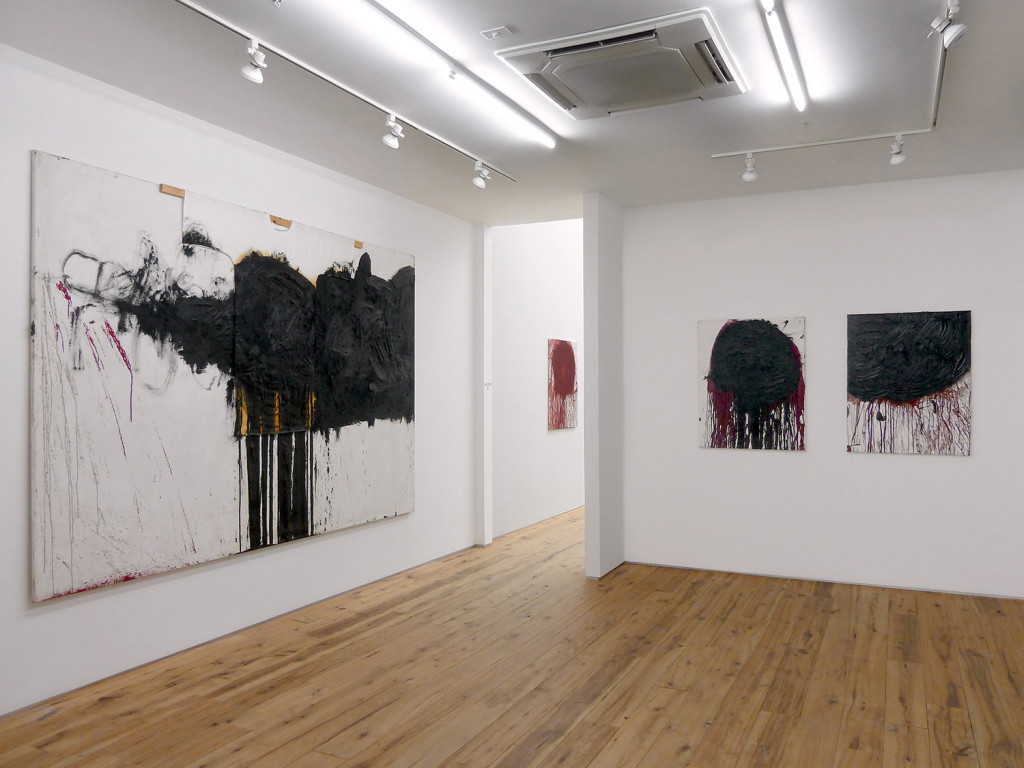
Hermann Nitsch, Installation view at Marc Strauss Gallery, NY, Photograph courtesy of the gallery, 2015
An important element of many of the paintings in the artist’s oeuvre, is a large white (sometimes painted) smock affixed to the canvas. It is the body (the bread or the self), intact and separate. In the simplest revelation, his works are self portraits, made by the body, directed as if a documentary film, spiritual and raw. At the Museo Nitsch, even several of the employees seemed to recoil (even if by a subtle gesture of the head or slight squinting of their eyes) when explaining the works. Verbally described as beautiful, however shocking, Naples −and also one could argue New York− with it’s historical resonance and breadth, is a perfect, if unexpected home for Nitsch, a place where life and art overlap on a daily basis.
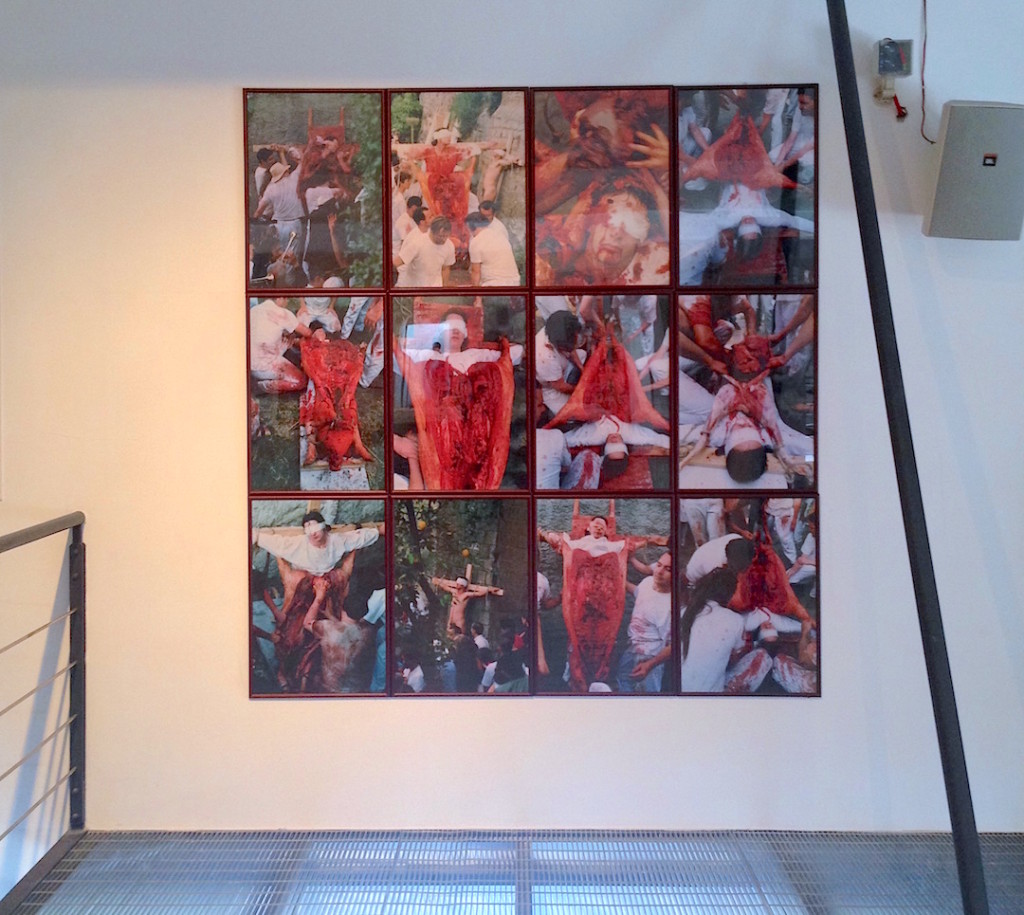
Hermann Nitsch, Installation view (photographic stills from performance with pig), at Museo Nitsch, Naples, Photograph Katy Hamer, 2015
Museo Archivio Laboratorio Per Le Arti Contemporanee Hermann Nitsch, vico lungo Pontecorvo 29/d, 80135 Napoli, it is open Monday through Friday 10am – 7pm and Saturday 10am – 2pm.
Marc Straus Gallery is showing ‘Hermann Nitsch’ until October 18th, 2015 and is located at 299 Grand Street, in Manhattan
- Hermann Nitsch & Korakrit Arunanondchai at Marc Strauss Gallery, NY, Photograph by Katy Hamer
- Tissues, medical instruments, things to help ‘care for’, Museo Nitsch, Photograph by Katy Hamer, 2015
- Tissues, medical instruments, things to help ‘care for’, Museo Nitsch, Photograph by Katy Hamer, 2015
- Hermann Nitsch, Marc Strauss Gallery, NY, Photograph by Katy Hamer, 2015
- A photo of a photo, hanging in the Museo Nitsch, Naples
- Hermann Nitsch, Installation view (from a 2011 painting made in New York at Mike Weiss gallery), at Museo Nitsch, Naples, Photograph Katy Hamer, 2015
- Hermann Nitsch, Installation view, Museo Nitsch, Naples, Photograph Katy Hamer, 2015
- DVD collection of films on Hermann Nitsch at the Museo Nitsch, Photograph by Katy Hamer, 2015
- Chemistry, installation at Museo Nitsch, Naples, Photograph by Katy Hamer, 2015
- Hermann Nitsch, Museo Nitsch, Lower level view, Photograph by Katy Hamer, 2015

